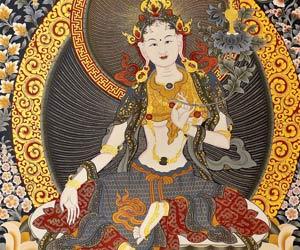Working with stipulations of Buddhist iconography, the thangka art form cannot be tampered with. An upcoming exhibition of paintings walks the thin line between tradition and reimagination


White Tara holds a small vase. She purifies great evil, wrongs and obstructions
ADVERTISEMENT
Carrying a legacy of thousands of years, Thangka is a Buddhist form of art that traces its origins back to Tibet. It's said to be one of the most complex forms of traditional arts that exists, one that would take the artist anywhere from five to 10 years to master. Tara, the female avatar of Buddha, is among the many subjects that have been depicted through the thangka form. A series of 21 paintings, portraying Tara in 21 avatars will be exhibited in the city later this month, giving viewers a chance to experience the Bhutanese thangka, that has its origins in Central Tibet. The paintings have been put together by 20 artists who have been working tirelessly for a year and a half. Each painting requires two to three months to be completed. They were done in sets of seven, where the sketching itself took 15 to 20 days.

Zeiko (second from right, standing) with a group of thangka artists
What sets the thangka apart from other kinds of art is the fact that it is created within specifications of Buddhist iconography. Zeiko, one of the artists who worked on the series, tells us, "The thangka works on measurements, and one must stick to proportions as there is a science behind it, which you should not tamper with. The freedom of expression lies in what we do around it, with the backdrop. That is all fantasy." He clarifies that the stipulation does not pose a hindrance to the artist. "This art form is quite mathematical. The Tara or any other form of thangka cannot be drawn randomly. And, this is the only way we know, because we have learnt it that way," he adds.

Red Tara - she has a bow and arrow to magnetise beneficial wisdom essences
In Bhutan, where he grew up, artists start learning the thangka in school, paralleled with their studies. There are many who even skip formal education to learn this art, which paves the way to their livelihood. For this series, in terms of colouring only natural earth pigments have been used on a rice paper canvas. "The series shows Tara in many forms - wrathful, happy, a Tara for prosperity, protection and peace. What she holds in her left hand, is what she represents," Zeiko tells us. For instance, a blue-black Tara holds a pestle that crushes negativities and obstacles, the white Tara holds a white umbrella to protect against nightmares and violence. Each canvas is five feet by four feet in dimension. 'The thangka art was not meant for decor in people's homes. They were created for monasteries, for the purpose of prayer. And there's a specific Tara for each kind of prayer, depending on what you're seeking," Zeiko says.
This series has the artists experimenting with print, pattern and design to reinterpret Tara. Curator Tania Le Fabvre from Bhutan who is bringing this exhibition to Mumbai, in collaboration with co-curator Arjun Sawhney, says, "The number of good thangka artists in Bhutan is dwindling, so we are very lucky to have worked with this group. What they have done in this series is new even to them, but they were open to experimenting with colour, schemes and contexts, while sticking to tradition."
One striking feature about this exhibition are the statues that will be mirroring each painting. They are hand-made, three-dimensional and made of mud. "Everywhere else they are made of brass or copper or some form of metal. In Bhutan, they are made of mud, and then hand-painted. The paintings are so intricate, and to recreate the same style using something so fragile as mud was an ambitious task which the artists have managed to accomplish," Fabvre says.
Catch up on all the latest Mumbai news, crime news, current affairs, and also a complete guide on Mumbai from food to things to do and events across the city here. Also download the new mid-day Android and iOS apps to get latest updates
 Subscribe today by clicking the link and stay updated with the latest news!" Click here!
Subscribe today by clicking the link and stay updated with the latest news!" Click here!






